Feature: 2. Initiatives to Counter Global Warming
Chugai is undertaking initiatives to counter global warming by reducing CO2 emissions from energy consumption and working to prevent the release of halogeneted hydrocarbons.
Reducing Energy Consumption
(1) Performance in 2010
In 2005, the Chugai Group set a goal of reducing its CO2 emissions in 2012 to the level of the baseline year of 2003 (the year after the merger with Roche), and has been working to counter global warming. However, despite ongoing efforts to reduce energy consumption, mainly at plants and research laboratories, total CO2 emissions in 2010 were approximately 104,000 tons, about 27,600 tons in excess of the 2003 baseline output of 76,400 tons.
(2) Outlook for Achievement of the Goal
The above excess is the result of new buildings constructed in and after 2007, the plans for which had not been finalized when the emissions goal was being considered in 2004. Including new building construction from 2004 to 2006, total floor area in 2010 was about 30 percent greater than in 2003. Moreover, expansion of biologic medicine manufacturing and research and development facilities, which consume a large amount of energy relative to floor area, had a significant impact.
Without the reduction measures implemented since 2003, CO2 emissions in 2010 would have been 144,000 tons. The 2010 figure of 104,000 tons therefore represents a reduction of about 40,000 tons. This reduction is the result of the measures we have implemented over the last seven years, including the conversion from heavy oil to city gas for boiler fuel starting in 2005, and the closure of some small-scale sites. However, despite efforts to reduce CO2 emissions at each site, we will have difficulty reaching our goal of 2003 levels by the end of 2012.
Chugai Group CO2 Emissions
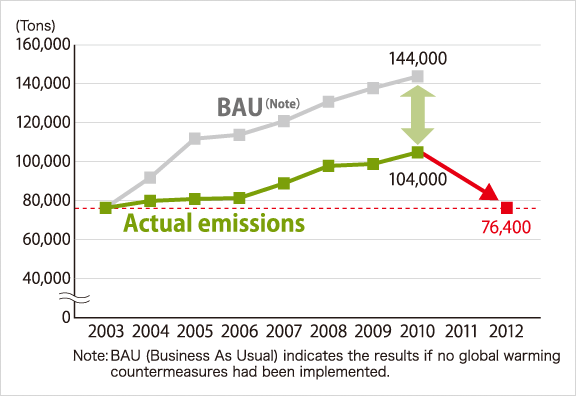
(3) Formulation of New Mid-Term Action Plan
New legal and regulatory obligations for CO2 emission reductions were set in 2010. Therefore, we have formulated a new mid-term action plan for the Chugai Group that includes goals and capital investment plans.
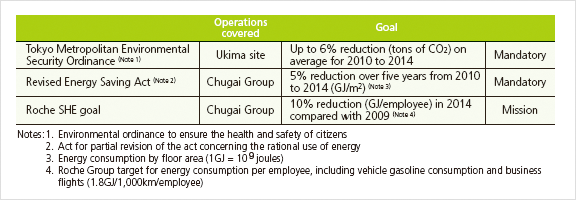
In order to respond as best we can to the revised Energy Saving Act, we are taking proactive measures to reduce energy consumption not just at the Ukima site, which is subject to the Tokyo Metropolitan Environmental Security Ordinance, but at all sites. Measures include selecting equipment that is more energy efficient when renewing facilities.
In addition, for the Chugai Group we have set the goal of a 10 percent reduction of energy consumption (gigajoules (GJ) per employee) in 2014 compared with the 2009 level, which is identical to the Roche safety, health and environmental protection (SHE) goal. As part of this effort, we are increasing the percentage of hybrids and other low-emission vehicles in our sales fleet.
Discontinuation and Replacement of Halogenated Hydrocarbons
Domestic regulations on halogenated hydrocarbons in Japan consist only of the Law Concerning the Protection of the Ozone Layer through the Control of Specified Substances and Other Measures and the Law Concerning the Recovery and Destruction of Fluorocarbons, which do not regulate use. However, many halogenated hydrocarbons have a global warming potential several thousand times that of CO2, so the leakage of even small amounts of these gases can have a significant impact on global warming. Therefore, the Chugai Group will replace all specified ozone-depleting chlorofluorocarbons (CFCs) (about 10 tons in total in the Group’s refrigerating and air-conditioning equipment) with ozone-safe hydrofluorocarbons (HFCs) by the year 2020. In addition, because HFCs also contribute to global warming, we will consider switching in the future to refrigerants such as CO2 and ammonia, which have relatively little impact on global warming. In the meantime, we will strictly control CFCs and HFCs to limit the amount refilled due to leakage to less than 1 percent annually. We discontinued the use of halon fire extinguishers in 2010.
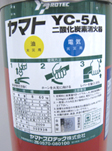
Chugai has replaced
its halon fire extinguishers
with CO2 extinguishers.
Adoption of Low-Emission Vehicles
Chugai is systematically introducing hybrid vehicles to the fleet of sales vehicles used by MRs, with the goal of increasing the percentage of hybrids to 50 percent by 2012. In 2010, we added 258 hybrids, bringing the cumulative total to 702. As a result, hybrids now make up 37.0 percent of our sales vehicles (40.9 percent excluding all-wheel drive vehicles used in cold regions), and we are moving steadily toward the 2012 goal. We are also considering the full-scale introduction of electric vehicles. Toward this end, we have introduced the i-MiEV on a trial basis at three sites (Kamakura Research Laboratories, Fuji- Gotemba Research Laboratories and the Fujieda plant of Chugai Pharma Manufacturing Co., Ltd.).
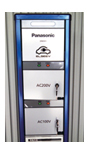
Charger
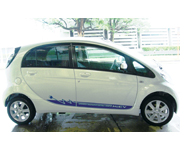
Electric vehicle (i-MiEV)
- Achievements Made Possible by People Working Together
-
I have been in the Facilities Group of the Ukima plant for 13 years. Since 2003, I have been working on the Group-wide project to reduce CO2 emissions and on our responses to the Energy Saving Act, the Tokyo Metropolitan Environmental Security Ordinance and other regulations. Initially, the emphasis in energy-saving measures was on cost saving, but recently the focus has shifted more to preserving the environment, as we can see in the mandatory Tokyo Metropolitan Environmental Security Ordinance. We have implemented various measures with the cooperation of many people, both internal and external. Our initiatives have been successful because everyone worked together. Regulations are expected to become even stricter, so we will need the further understanding and cooperation of everyone concerned. I was reassigned to the Fujieda plant in January 2011, so my position has changed, but I want to continue cooperating.
Mitsuhiro Takano
Ukima Plant, Maintenance & Utilities Group, Chugai Pharma Manufacturing Co., Ltd.
